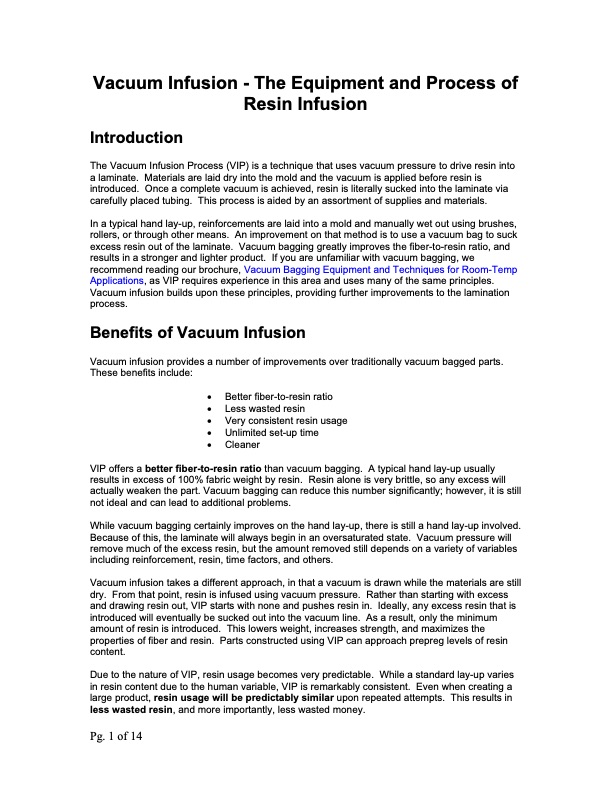
PDF Publication Title:
Text from PDF Page: 001
Vacuum Infusion - The Equipment and Process of Resin Infusion Introduction The Vacuum Infusion Process (VIP) is a technique that uses vacuum pressure to drive resin into a laminate. Materials are laid dry into the mold and the vacuum is applied before resin is introduced. Once a complete vacuum is achieved, resin is literally sucked into the laminate via carefully placed tubing. This process is aided by an assortment of supplies and materials. In a typical hand lay-up, reinforcements are laid into a mold and manually wet out using brushes, rollers, or through other means. An improvement on that method is to use a vacuum bag to suck excess resin out of the laminate. Vacuum bagging greatly improves the fiber-to-resin ratio, and results in a stronger and lighter product. If you are unfamiliar with vacuum bagging, we recommend reading our brochure, Vacuum Bagging Equipment and Techniques for Room-Temp Applications, as VIP requires experience in this area and uses many of the same principles. Vacuum infusion builds upon these principles, providing further improvements to the lamination process. Benefits of Vacuum Infusion Vacuum infusion provides a number of improvements over traditionally vacuum bagged parts. These benefits include: • Better fiber-to-resin ratio • Less wasted resin • Very consistent resin usage • Unlimited set-up time • Cleaner VIP offers a better fiber-to-resin ratio than vacuum bagging. A typical hand lay-up usually results in excess of 100% fabric weight by resin. Resin alone is very brittle, so any excess will actually weaken the part. Vacuum bagging can reduce this number significantly; however, it is still not ideal and can lead to additional problems. While vacuum bagging certainly improves on the hand lay-up, there is still a hand lay-up involved. Because of this, the laminate will always begin in an oversaturated state. Vacuum pressure will remove much of the excess resin, but the amount removed still depends on a variety of variables including reinforcement, resin, time factors, and others. Vacuum infusion takes a different approach, in that a vacuum is drawn while the materials are still dry. From that point, resin is infused using vacuum pressure. Rather than starting with excess and drawing resin out, VIP starts with none and pushes resin in. Ideally, any excess resin that is introduced will eventually be sucked out into the vacuum line. As a result, only the minimum amount of resin is introduced. This lowers weight, increases strength, and maximizes the properties of fiber and resin. Parts constructed using VIP can approach prepreg levels of resin content. Due to the nature of VIP, resin usage becomes very predictable. While a standard lay-up varies in resin content due to the human variable, VIP is remarkably consistent. Even when creating a large product, resin usage will be predictably similar upon repeated attempts. This results in less wasted resin, and more importantly, less wasted money. Pg. 1 of 14PDF Image | Vacuum Infusion

PDF Search Title:
Vacuum InfusionOriginal File Name Searched:
FibreGlast_Vacuum_infusion_process.pdfDIY PDF Search: Google It | Yahoo | Bing
5,000 BF Shipping Container Lumber Dry Kiln For Quality Lumber The 5,000 BF container kiln consists of one 40 foot high-cube aluminum shipping container... More Info
Shipping Container Lumber Dry Kilns by Global Energy Global Energy designed and developed the container kiln back in 1991. The purpose is to give access to portable sawmill owners, furniture makers, and small business the value added profit of dry kiln lumber and quality hardwoods... More Info
Vacuum Kiln Conversion Kit for Lumber and Wood Dry Kilns Convert your existing conventional dry kiln into a fast drying vacuum kiln. Similar to vacuum bagging in the boat building and aircraft industry, we have come up with a proprietary process which allows you to build a very simple vacuum kiln at a fraction of the price, and without the intensive conventional metal chamber structure... More Info
Vacuum Pump Cart System for Bagging Clamping Wood Drying and more Vacuum Cart with 2HP Pump and Dual Pistons with multiple multiplex vacuum ports and liquid reservoir... More Info
Vacuum Bagging Basics Vacuum bagging is a method of clamping, which has traditionally been used in the composites industry, but can also be used for vacuum drying materials, including wood products... More Info
| CONTACT TEL: 608-238-6001 Email: greg@globalmicroturbine.com | RSS | AMP |